stop start AUDI A5 COUPE 2013 Owner's Guide
[x] Cancel search | Manufacturer: AUDI, Model Year: 2013, Model line: A5 COUPE, Model: AUDI A5 COUPE 2013Pages: 294, PDF Size: 73.84 MB
Page 201 of 294
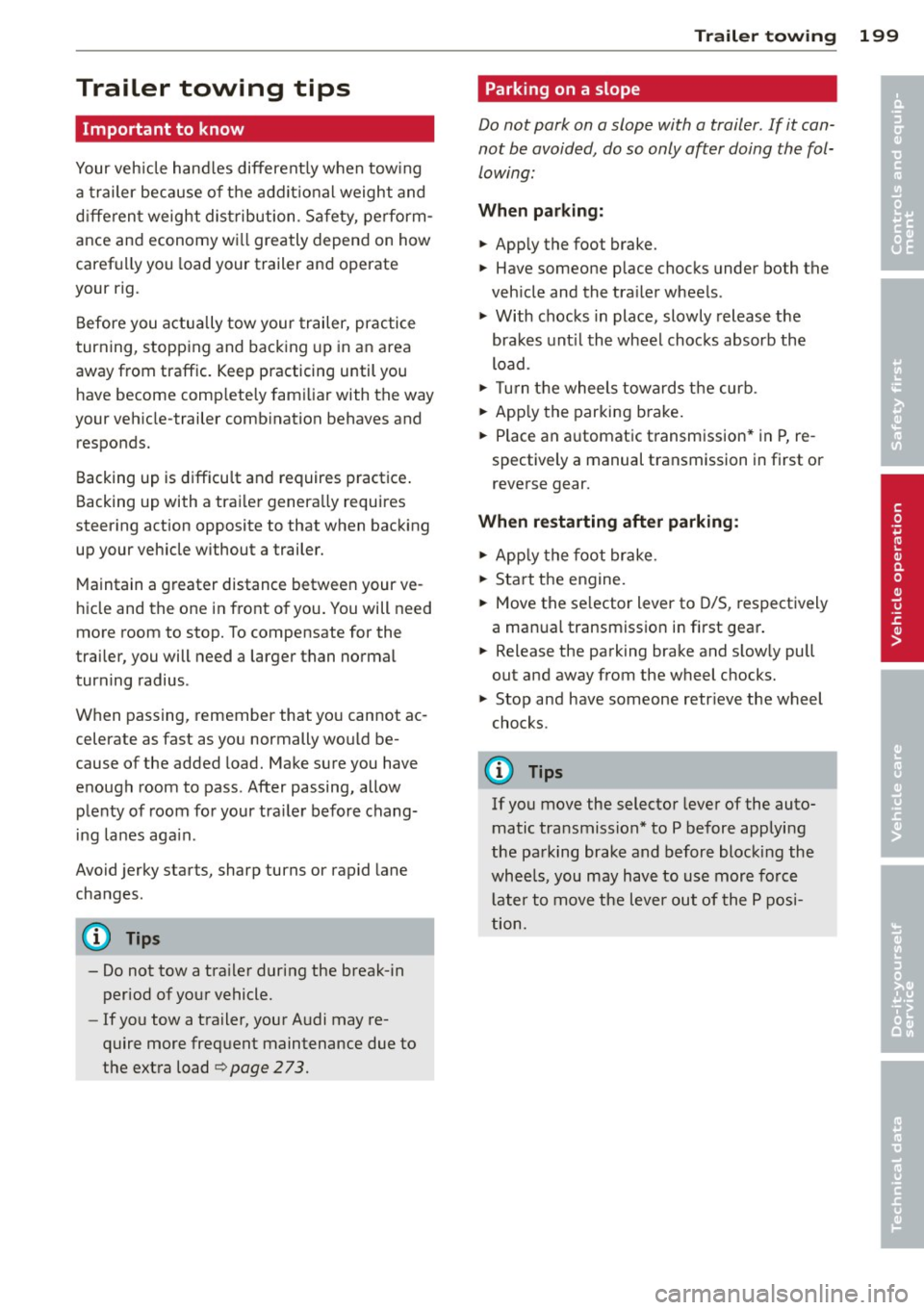
Trailer towing tips
Important to know
Your vehicle hand les different ly when tow ing
a trailer because o f the addit ional weight and
d iffe ren t weight distribution . Safety, perform
ance and economy w ill greatly depend on how
caref ully you load your trailer and operate
your rig.
B efore you actua lly tow your trailer, pr actice
turning, stopp ing and bac king up in an area
away from traffic. Keep practicing until you have become comp lete ly fam iliar with the way
your veh icle-trailer comb ination behaves and
responds.
Backing up is d ifficu lt a nd requires practice .
Backing up with a tra iler genera lly requires
steer ing action opposite to that when backing
up your vehicle without a trailer.
M aintain a g reater distance betwee n your ve
h icle and the one in front o f you . You will need
mo re room to stop. To compensate for the
trailer, you will need a larger than normal
turning radius .
W hen pass ing, remember that yo u cannot ac
celerate as fast as yo u normally wo uld be
cause of the added load. Ma ke s ure you have
e nough room to pass . After passing , allow
p lenty o f room fo r your tra iler before chang
in g la nes aga in .
Avoid jerky starts, sharp turns or rap id lane
changes.
(D Tips
- Do not tow a tra iler during the break-in
period of you r vehicle.
- If you tow a trailer, your A udi may re
quire more frequent maintenance due to
the extra load
o page 2 73.
Trailer towin g 199
Parking on a slope
Do not park on a slope with a trailer . If it can
not be avoided, do so only after doing the fol lowing:
When parking:
.. App ly the foot brake.
.. Have someone p lace chocks under both the
veh icle and the tra iler wheels .
.,. With chocks in place, slowly release t he
bra kes unt il t he whee l chocks absorb the
load .
.. Tur n the whee ls towa rds t he curb .
.,. App ly the parking brake.
.. Place an a utomat ic t ransm ission* in P, re
spectively a manual transmission in first or
reverse gear.
When restarting after parking:
.. App ly the foot br ake .
.. Sta rt t he engine.
.. Move the se lector lever to D/S, respectively
a man ual transmiss ion in first gear .
.. Release the parking brake and s low ly pull
out and away from the wheel chocks .
.. Stop and have someone retr ieve the wheel
chocks.
@ Tips
If you move the selector leve r of the auto
matic transmissio n* to P before applying
the pa rking brake and before bloc king the
whee ls, you may hav e to use mor e forc e
la ter to m ove the lever out of the P p osi
tion.
•
•
Page 240 of 294
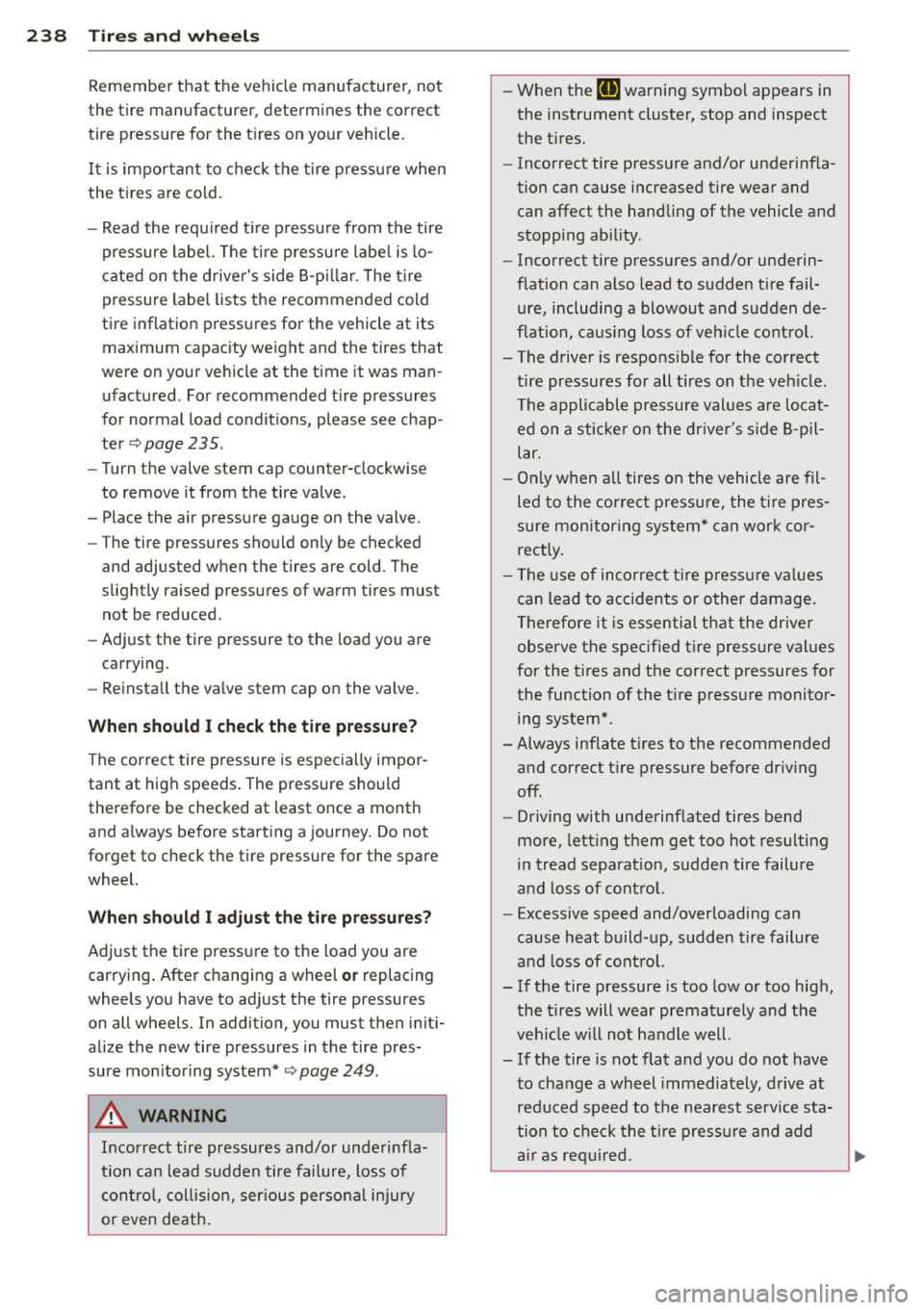
238 Tire s and whee ls
Remember that the vehicle manufacturer, not
the tire manufacturer, determines the correct
tire pressure for the t ires on your vehicle.
I t is important to check the tire pressu re when
the tires are cold.
- Read the requ ired t ire pressure from the tire
pressure label. The tire pressure labe l is lo
cated on the drive r's side 8-p illar. The tire
pressure label lists the recommended cold
tire inflation pressures for the vehicle at its maximum capacity we ight and the tires that
were on your vehicle at the time it was man ufactured . For recommended tire pressures
for normal load condit ions, please see chap
ter ¢
page 235 .
-Turn the valve stem cap coun ter-clockwise
to remove it from the tire valve .
- Place the air pressure gauge on the valve .
- The tire pressures should on ly be checked
and adjusted when the tires are cold . The
s lightly raised pressures of warm tires must
not be reduced .
- Adjust the tire pressure to the load you are
carrying.
- Re install the valve stem cap on the valve .
When should I check th e tire p ressur e?
The correct tire pressure is especially impor
tant at high speeds . The pressure should
therefore be checked at least once a month
and a lways before starting a journey . Do not
forget to check the tire pressure for the spare
wheel.
When should I adju st the tire pre ssure s?
Adjust the tire pressure to the load you are
carrying. After changing a wheel
or replacing
wheels you have to adjust the tire pressures
on all wheels. In addition, you must then init i
alize the new tire pressures in the tire pres
sure mon itor ing system*
¢ page 249 .
A WARNING
Incorrect tire pressures and/or underinf la
tion can lead sudden tire failure, loss of contro l, collision, ser ious persona l inju ry
or even death. -
When the
[ti warning symbol appears in
the instrument cluster, stop and inspect
the t ires.
- Incorrect tire pressure and/or underinfla
tion can cause increased tire wear and can affect the handling of the vehicle and
stopping ability .
- Incorrect tire pressures and/or underin
flation can a lso lead to sudden t ire fail
ure, including a blowout and sudden de
flation, caus ing loss of veh icle control.
- The driver is responsible for the correct
tire pressures for all tires on the veh icle.
The applicable pressure values a re locat
ed on a sticker on the dr iver's s ide 8-pil
lar.
- Only when all tires on the vehicle are fil
led to the correct pressu re, the t ire pres
sure mon itor ing system* can work cor
rectly.
- The use of incorrect tire p ressure va lues
can lead to acc idents or other damage .
Therefore it is essential that the driver
observe the spe<;ified tire pressure val ues
for the tires and the correct pressures for
the function of the tire pressure monitoring system*.
-Always inf late tires to the recommended
and correct t ire pressure before dr iving
off.
- Driving with underinflated tires bend
more, letting them get too hot resulting
in tread separation, sudden tire failure
and loss of control.
- Excessive speed and/overloading can
cause heat build-up, sudden tire failure
and loss of control.
- If the tire pressure is too low or too high,
the t ires will wear prematurely and the
veh icle w ill not handle well.
- If the tire is not flat and you do not have to change a wheel immediately, drive at
reduced speed to the nearest service sta
tion to check the t ire press ure and add
ai r as requ ired .
Page 251 of 294
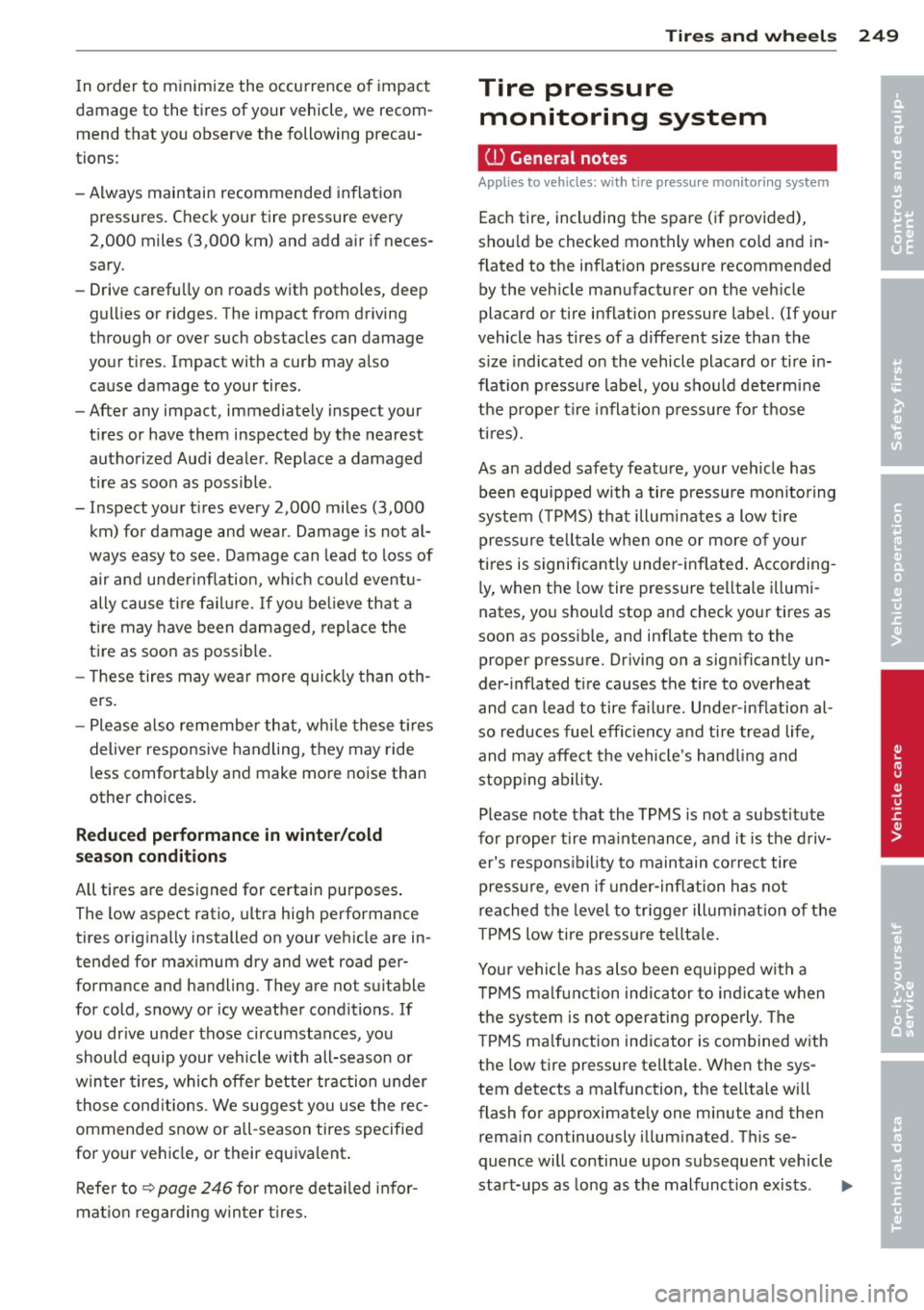
In o rder to minimize the occurrence o f impact
damage to the tires of your vehicle, we recom mend that you observe the following precau
tions :
- Always maintain recommended inflation
pressures. Check your tire pressure every
2,000 miles (3,000 km) and add a ir if neces
sary.
- Drive carefu lly on roads with potholes, deep
gullies or ridges. The impact from driving
through or over such obstacles can damage
your tires. Impact with a curb may also cause damage to your tires .
- After any impact, immediately inspect your
tires or have them inspected by the nearest
authorized Aud i dealer . Replace a damaged
t ire as soon as poss ible .
- In spect your t ires every 2,000 miles (3,000
km) for damage and wear . Damage is not al
ways easy to see. Damage can lead to loss of
air and unde rinflation, wh ic h could eventu
ally cause ti re fail ure.
If yo u be lieve that a
ti re may have been damaged , replace the
tire as soon as possible.
- These tires may wear more quick ly than oth
ers.
- Please a lso remembe r that, whi le these t ires
deliver respons ive handling, they may ride
less comfortably and make more noise than
other c hoices.
Reduced p erformance in winter /cold
s ea son condit ion s
All ti res are designed for certain purposes .
The low aspect ratio, ultra hig h performance
tires originally installed on your veh icle are in
tended for max imum dry and wet road per
formance and handling . They are not suitable
for cold, snowy or icy weather cond it ions . If
you dr ive under those circumstances, you
should equip your vehicle with all-season or
winter tires, whi ch offe r better traction under
those cond it ions . We suggest you use the rec
ommended snow or all -season tires specified
for your ve hicle, or their equiva lent .
Refe r to ~
page 246 for mo re deta iled info r
mat io n regarding w in ter t ires.
Tire s an d wheel s 249
Tire pressure
monitoring system
ill General notes
App lies to vehicles : wi th tire p ress ure mo nito rin g system
Each tire, incl uding the spare (if provided),
shou ld be checked monthly when co ld and in
flated to the inflation pressure recommended
by the veh icle manufacturer on the veh icle
placard or tire inflation pressure label. (If your
vehicle has tires of a d ifferent size than the
s iz e indicated on the vehicle placard or tire in
flat io n pressu re labe l, you shou ld dete rmine
the p roper t ire inflation p ress ure fo r those
t i r es).
As an added safety feature, your veh icle has
been equipped with a tire pressure monitoring
system ( TPMS) that illum inates a low ti re
pressure te lltale whe n one or more o f your
ti res is significant ly under -inflated . According
ly, when the low tire pressure te lltale i llumi
nates, you shou ld stop and check your tires as
soon as possib le, and inflate them to the
proper pressure. Driving on a sign ificantly un
der- inflated t ire causes the tire to overheat
and can lead to tire fa ilure . Under-inflation al
so reduces fuel effic iency and tire tread life,
and may affect the vehicle 's hand ling and
stopp ing abil ity.
Please note that the TPMS is not a subst itute
fo r proper tire ma intenanc e, and it is the d riv
er's respo nsibility to maintain co rrect tire
pressure, even if under-inflation has not
reached the leve l to tr igger illum inat ion of the
T PMS low ti re p ressu re tellta le .
You r vehicle has also been equipped with a
T PMS ma lf u nction indicator to ind icate w hen
the sys tem is not operating prope rly . T he
T PMS ma lfunction indicator is combined w ith
the low tire pressure te lltale. When the sys
tem detects a malfunction, the telltale wi ll
flash for approximate ly one min ute and then
rema in con tinuously i llum inated . T hi s se
quence will continue upon subsequent vehicle
start-ups as long as the malfunct ion exists . ..,.
•
•
Page 282 of 294
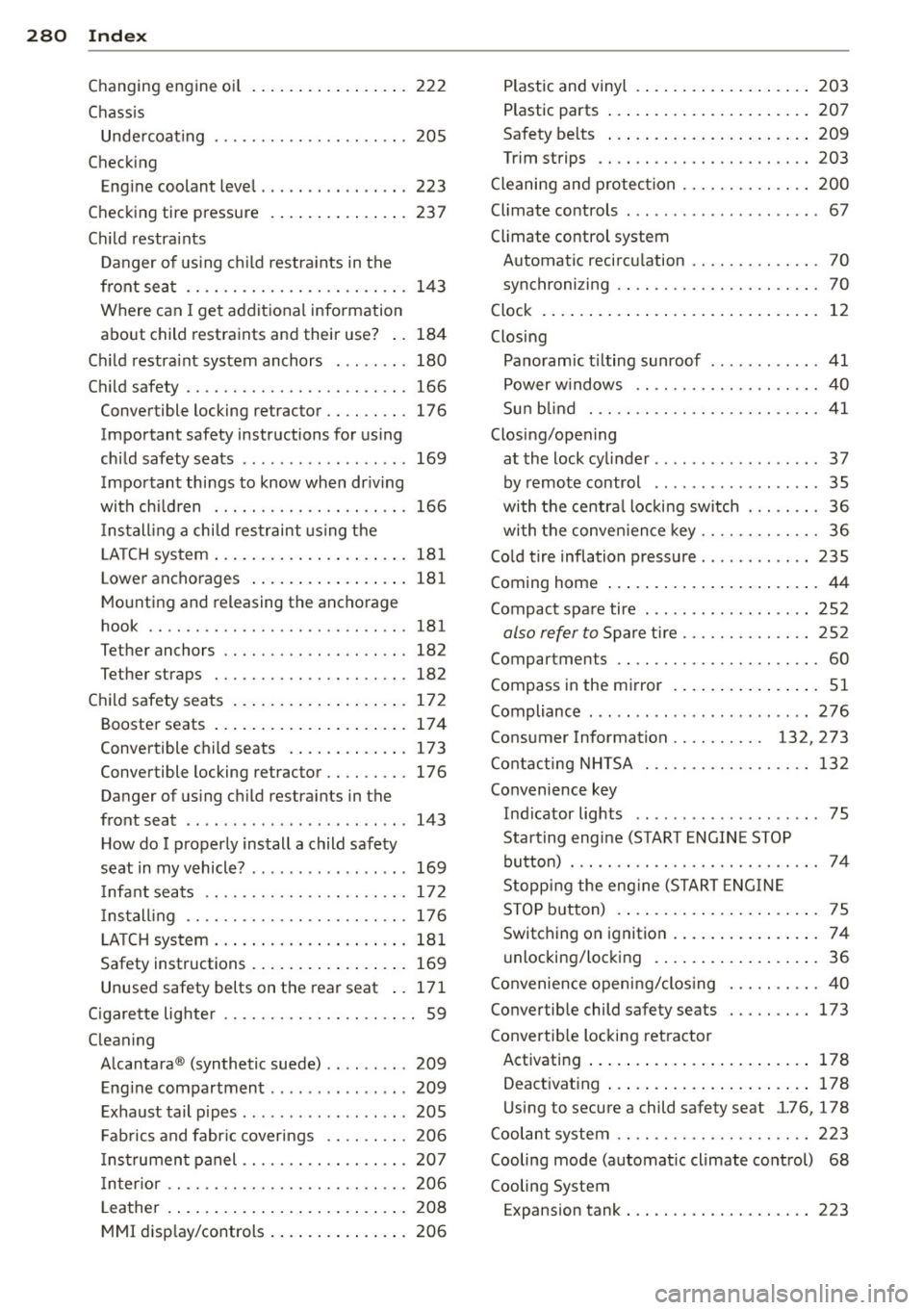
28 0 Index
Changing engine o il
Chass is 222
Unde rcoat ing . ........... .... .... . 205
Checking
Eng ine coolant leve l .... ... .. .. .. .. .
223
Checking tire pressure . ... .. .. .. .. .. . 237
Ch ild restra ints
Da nger of us ing ch ild restra ints in the
front seat . . . . . . . . . . . . . . . . . . . . . . . .
143
Where can I get additional information
about child restraints and their use? ..
184
Ch ild restra int system anchors . .. .. .. . 180
Ch ild safety .. .. . .......... .. .. .... . 166
Convertible locking retractor . . . . . . . . . 176
Important safety instructions for us ing
ch ild safety seats .. ..... .. .. .. .. .. .
169
Important th ings to know when dr iving
with ch ildren . ............. .. .... .
166
Ins tall ing a chi ld restraint using the
L A T C H system .. ... .... ... .. .. .... .
181
Lower anchorages ..... ... .. .. .... . 181
Mounti ng and releasing the ancho rage
hook .. .. .. ............. .. .. .. ...
181
Tether anchors . . . . . . . . . . . . . . . . . . . . 182
Tether straps . . . . . . . . . . . . . . . . . . . . . 182
Chil d safety seats .. ..... ... .. .. .... . 172
Booste r seats .. .. ..... ... .. .. .... . 174
Convertible child seats .... .. .. .... . 173
Convertible locking retractor .. .. ..... 176
Danger of us ing ch ild restra ints in the
front seat . . . . . . . . . . . . . . . . . . . . . . . .
143
H ow do I properly install a child safety
seat in my vehicle? ............ .. ...
169
Infant seats ............. .. .. .. .. . 172
Ins tall ing .. ... .......... .. .. .. .. . 176
LA T CH system .. .. ..... ... .. .. .... . 181
Safety instructions ..... ... .. .. .... . 169
Unused safety belts on the rear seat . . 17 1
Cigare tte lig hte r . . . . . . . . . . . . . . . . . . . . . 59
C leaning
A lcantara ® (synthetic suede) .. .. .. .. .
209
Eng ine compartment .......... .. ... 209
Exhaust tail p ipes ...... .... ... .. .. . 205
Fab rics and fabr ic coverings .. .. ..... 206
Instrument panel ....... .. .. .. .. .. . 207
In ter ior .. ... ............ .. .. .. .. . 206
Leather ..... .. .. ..... ... .. .. .... . 208
MMI disp lay/controls . ... .. .. .... .. . 206
Plastic and vinyl . .... .. ..... .... . .. 203
Plastic parts ..... .. ... ..... ... .. .. 207
Safety be lts ... .. ... .. ..... ... .. .. 209
Tr im strips .... .. ............. .... 203
Cleaning and p rotection .......... .... 2 00
Cl imate controls ... ..... ........... .. 67
Climate control system
Automatic recircu lation ......... .... .
70
synchroni zing .. .. ............. .. .. . 70
Clock . . . . . . . . . . . . . . . . . . . . . . . . . . . . . . 12
Closing
Panoramic t ilting sunroof ........ ... .
41
Power w indows ... ............ .. .. . 40
Su n blind ..... .. .. ........... .... . 41
Closing/opening
at the lock cylinder . . . . . . . . . . . . . . . . . . 3 7
by remote control ..................
35
with the centra l locki ng switch ... .... . 36
with the conven ien ce key ........ .. .. . 36
Co ld tire inflation pressure . ........... 235
Coming home ..... ... .. ..... ... .. .. . 44
Compact spare tire . .. .. ...... ... .. .. 252
also refer to Spare ti re .......... .... 252
Compartments . . . . . . . . . . . . . . . . . . . . . . 60
Compass in the mirror . .. ..... ... .. .. .
51
Compliance . ...... .. .............. . 276
Consumer Information . . . . . . . . . . 132, 273
Contacting NHTSA . ... .......... .. .. 132
Convenience key
Indicator lights .. ... .. .. ... ..... .. .
75
Start ing engine (S TART E NGIN E STOP
button) ... .... ................... .
74
Stopping the eng ine (START ENG IN E
STOP b utton) .... .. .... .... ... .. .. .
75
Switching on ignition . .. ..... .... . .. . 74
unlocking/locking . .... ..... ... .. .. . 36
Co nvenience openi ng/clos ing ... .. .... . 40
Convertib le child safety seats ..... .... 173
Convertib le locking retractor
Activating ..... .. .. ... ..... ... .. ..
178
Deact ivat ing ... .. .. .... .... ... .. .. 178
Using to secure a child safety seat l.76, 178
Coolant system .. .. ... .......... .. .. 223
Cooling mode (automat ic cl imate co ntrol) 68
Cooling System
Expansion tank . .. ............. .. ..
223
Page 284 of 294
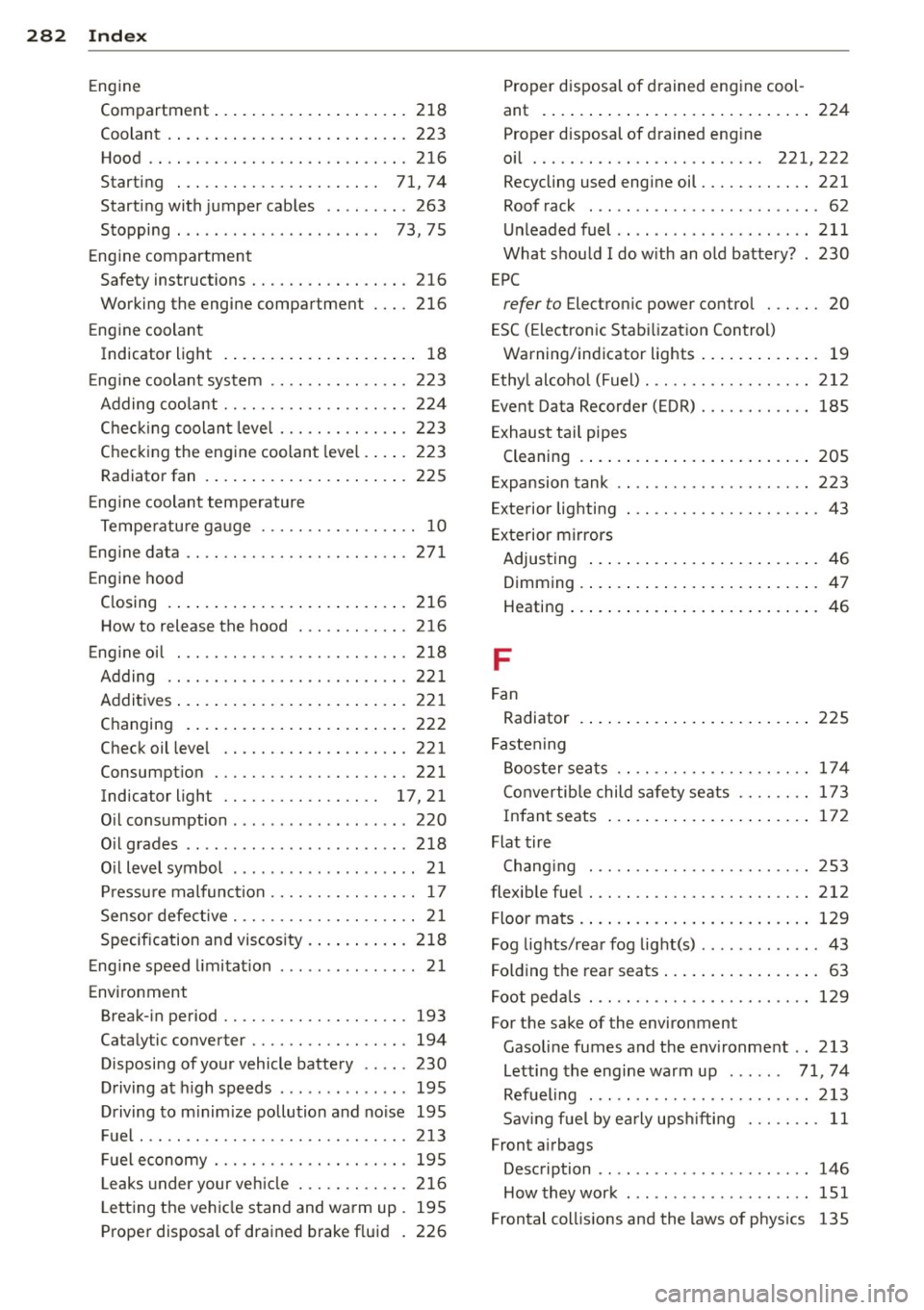
28 2 Index
Eng ine
Compartment .. . ...... ... .. .. .... . 218
Coolant .. .. ... ... .... ... .. .. .... . 223
Hood .. .. ............... .. .. .... . 216
Starting . . . . . . . . . . . . . . . . . . . . . . 71, 74
Starting with jumper cables .. .. .. ... 263
Stopping . . . . . . . . . . . . . . . . . . . . . . 73, 75
Engine compartment Safety instructions . . . . . . . . . . . . . . . . . 216
Working the engine compartment 216
Eng ine coolant
Indicator light . .. ..... ... .. .. .... .. 18
E ng ine coolant system ............... 223
Adding coo lant ......... .. .. .. .. .. . 224
Chec king coolant leve l ..... .. .. .... . 223
Check ing the eng ine coolant leve l .. .. . 223
Radiator fan . .. .. ..... ... .. .. .... . 225
E ng ine coolant temperature
Tempe ratu re ga uge ................. 10
Eng ine data .... ........... ........ . 271
E ngine hood
C losing . . . . . . . . . . . . . . . . . . . . . . . . . . 216
How to release the hood ... .. .. .. .. . 216 Proper disposal of d
rained eng ine cool -
ant . ... .. .... .. .. ... ..... ... .. .. 224
Proper d isposal of drained eng ine
o il ... .... .... .. ............ 221,222
Recycling used engine oil ........ .... 221
Roof rack . . . . . . . . . . . . . . . . . . . . . . . . . 62
Unleaded fuel .. .. ... .. ....... ... .. 211
What shou ld I do with an o ld battery? . 230
EPC
refer to Electronic power control . . . . . . 20
E SC (Electronic Stab ilizat ion Con trol)
Warning/indicator lights ..... ... .. .. . 19
E thy l alcoho l (Fuel) . ... .......... .. .. 212
Event Data Recorder (EDR) ........ .... 185
E xhaus t tail pipes
Cleaning . ..... .. ... .. ..... .... . .. 205
E xpansion tank .. .. ................ . 223
Exterior lighting . .. ... .......... .. .. . 43
E xterior mirrors
Adjusting ..... .. .. ... ..... ... .. .. . 46
Dimm ing . ..... .. .. ... ..... ... .. .. . 47
Heating ... .... .. .. ... ..... ... .. .. . 46
E ng ine oil ... ... .......... .. .. .. .. . 218
F
Adding .. .. ............. ........ . 22 1
Addit ives ... ... .. ..... ... .. .. .... . 22 1
C hanging . .... .. ..... ... .. .. .... . 222
Check oil leve l ........... .... .... . 221
Consumpt ion ............ .. .. .. .. . 221
Indicator ligh t ............. .. .. 17,21
O il consumption ............... .... 220
O il grades .. .......... ........ ... . 218
O il level symbol .............. .. .... 21
Pr essu re malfunct ion ................ 17
Sensor defective . . . . . . . . . . . . . . . . . . . . 2 1
Specif ication and viscos ity . ... .... .. . 2 18
E ng ine speed limitat ion .......... ..... 21
Environment Break- in period ............... .... . 193
Cata lytic converter ............ .... . 194
Disposing of your vehicle battery .. .. . 230
Driving a t high speeds ......... .. ... 195
D riving to m inim ize pollution and no ise 195
F uel . .. ................. .. .. ..... 2 13
Fu el economy .......... .. .. .. .. .. . 195
L eaks under your veh icle ... .. .. .. .. . 216
L etting the vehicle stand and wa rm up . 195
Proper disposal of drained brake fluid . 226 F
an
Radiator
Fastening 225
Boos ter sea ts . . . . . . . . . . . . . . . . . . . . . 17 4
Co nvertib le child sa fe ty seats . . . . . . . . 173
Infan t seats
Flat tire 172
Chang ing . .. .. .. ............. .. .. 253
flexib le fuel . .... .. ... .......... .... 212
Floor mats . ..... .. .. .... .... ... .. .. 129
Fog lights/rear fog light(s) ...... ....... 43
Fo lding the rear seats .... ..... ... .. .. . 63
Foot peda ls . ....................... 129
For the sake of the environment
Gasoli ne fumes and the env ironme nt .. 213
L etting the engine warm up . . . . . . 71, 74
Ref ueling . .. .. .. ............. .. .. 213
Sav ing f uel by early u pshi fting . .. .... . 11
Front a irbags
Description . . . . . . . . . . . . . . . . . . . . . . . 146
How they work ........ ........... . 151
Frontal coll is ions and the laws of phys ics 135
Page 290 of 294
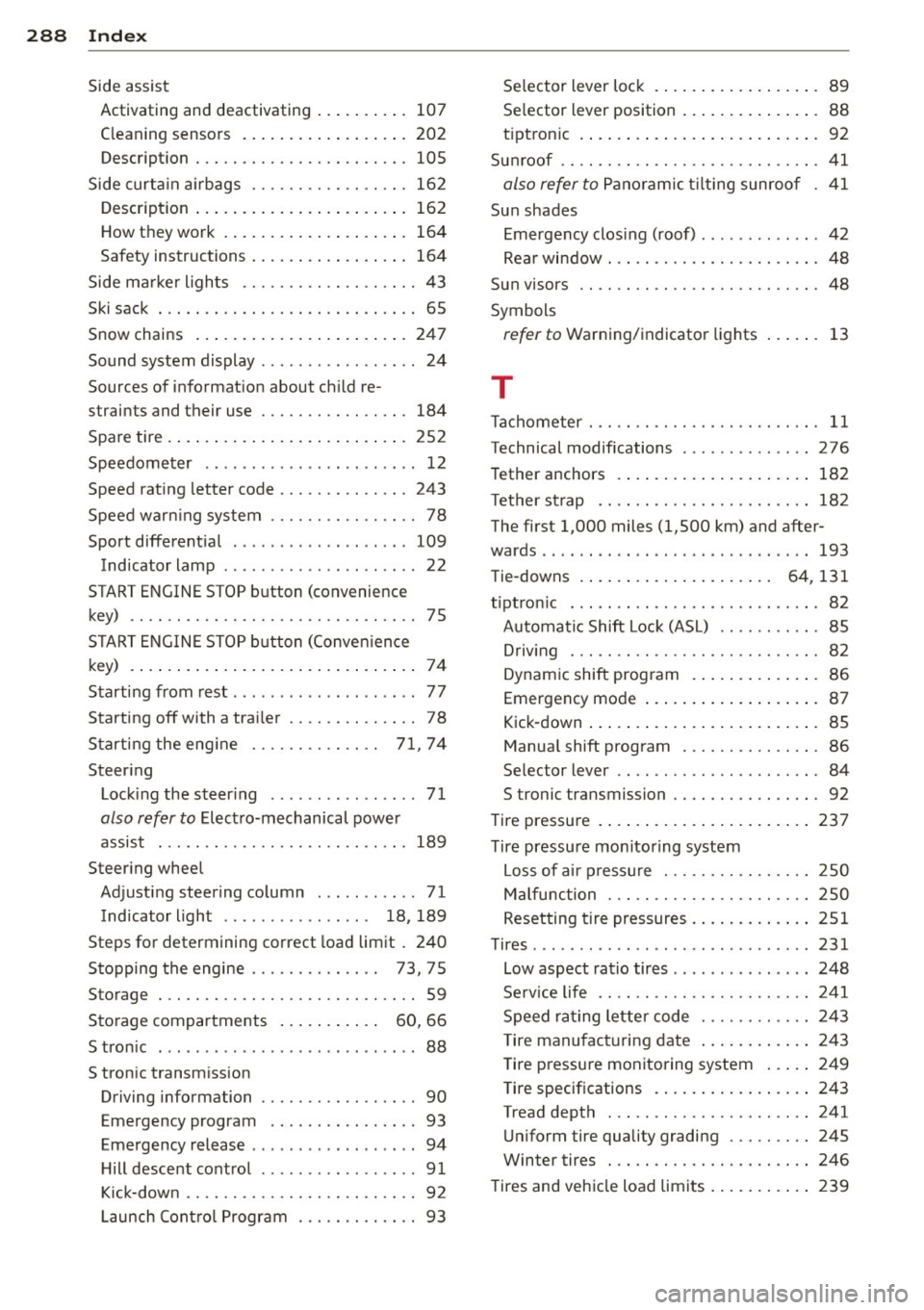
288 Index
Side assist Activating and deactivating . . . . . . . . . . 107
C leaning sensors .................. 202
Description .............. .. .. .... . 105
Side curtain airbags .......... .. .... . 162
Description ............... ... .... . 162
How they work ............ ... .... . 164
Safety instructions ................. 164
Side marker lights ......... .. .. .... .. 43
Ski sack ... .. .. . .......... .. .. .... .. 65
Snow chains ............... ... .... . 247
Sound system display . . . . . . . . . . . . . . . . . 24
Sources of information about child re-
straints and their use . . . . . . . . . . . . . . . . 184
Spare tire .... ................ ..... . 252
Speedometer . . . . . . . . . . . . . . . . . . . . . . . 12
Speed rating letter code ..... .. .. .. .. . 243
Speed warn ing system ...... .. .. .. .. . . 78
Sport different ial ........... ... .. .. . 109
Indicator lamp . . . . . . . . . . . . . . . . . . . . . 22
START ENGINE STOP button (convenience
key) .. .. .. ... ............ .. .. .. .. .. 75
START ENGINE STOP button (Convenience
key) . ... .... ................ ..... .. 74
Starting from rest . . . . . . . . . . . . . . . . . . . . 77
Starting off with a trai ler .... .. .. .... .. 78
Starting the eng ine . . . . . . . . . . . . . . 71, 74
Steering Locking the steer ing . . . . . . . . . . . . . . . . 71
also refer to Electro-mechanical power
assist ... ... ............ .. .. .. .. . 189
Steering wheel Adjusting steering column ... .. .. .. . . 71
Indicator light . . . . . . . . . . . . . . . . 18, 189
Steps for determining correct load limit . 240
Stopping the engine . . . . . . . . . . . . . . 73, 75
Storage ... .. ............... .. .... .. 59
Storage compartments . . . . . . . . . . . 60, 66
S tronic . .. .. ................ ... .. .. 88
S tronic transmission Driving information . . . . . . . . . . . . . . . . . 90
Emergency program .. .... .. .. .. .. . . 93
Emergency release . . . . . . . . . . . . . . . . . . 94
H ill descent control ........ ..... .. .. 91
Kick-down . . . . . . . . . . . . . . . . . . . . . . . . . 92
L aunch Control Program ... .. .. .... .. 93 Selector
lever lock . . . . . . . . . . . . . . . . . . 89
Se lector lever position . . . . . . . . . . . . . . . 88
t iptron ic . ... .. .. .. .............. .. 92
Sunroof .. .. .. .. .. ............. .. .. . 41
also refer to Panoramic tilting sunroof . 41
Sun shades Emergency closing (roof) ........... .. 42
Rear window ... .. ... .......... .. .. . 48
Sun visors .. .. .. .. ............. .. .. . 48
Symbols
refer to Warning/indicator lights ...... 13
T
Tac hometer . . . . . . . . . . . . . . . . . . . . . . . . . 11
Technical modifications .............. 276
Tether anchors .... ............. .... 182
T ether strap . . . . . . . . . . . . . . . . . . . . . . . 182
The first 1,000 miles (1,500 km) and after-
wards .. .. .. .. .. .. ... .... ...... .... 193
Tie-downs . . . . . . . . . . . . . . . . . . . . . 64, 131
tiptronic ... .. .. .. .... ...... ... .. .. . 82
Automatic Shift Lock (ASL) . . . . . . . . . . . 85
Driving ..... .. .. ... .......... .... . 82
Dynamic shift program ............. . 86
Emergency mode .............. ..... 87
Kick-down . . . . . . . . . . . . . . . . . . . . . . . . . 85
Manual shift program .......... .... . 86
Selector lever . . . . . . . . . . . . . . . . . . . . . . 84
S tronic transmission ... ..... ... .. .. . 92
Tire pressure . ..... ................ . 23 7
Tire pressure monitoring system
Loss of air pressure .. .......... .. .. 250
Malfunction . .. .. ............. .. .. 250
Resetting tire pressures ............. 251
Tires ........ ... .. .. ............... 231
Low aspect ratio tires . . . . . . . . . . . . . . . 248
Serv ice life .. .. .. ... .......... .... 241
Speed rating letter code ........ .. .. 243
T ire manufacturing date ............ 243
Tire pressure monitoring system ..... 249
Tire specifications ................ . 243
Tread depth ..... ............. .... 241
Uniform tire quality grading ..... .... 245
Win ter tires ... .. ............. .. .. 246
Tires and vehicle load limits ......... .. 239